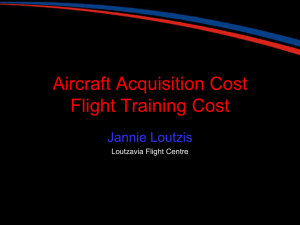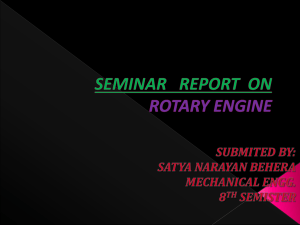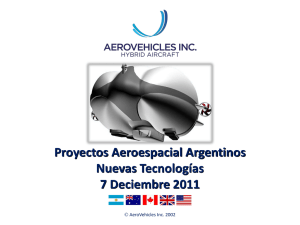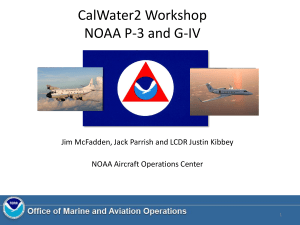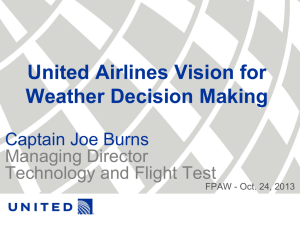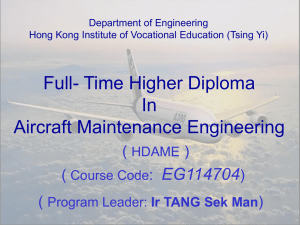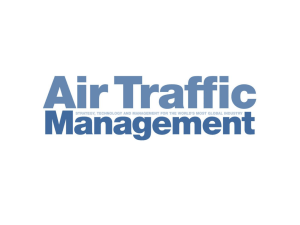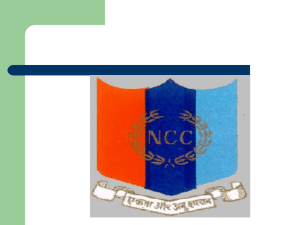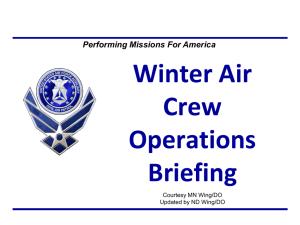Non Standard Installations in the F-16: Regaining
advertisement
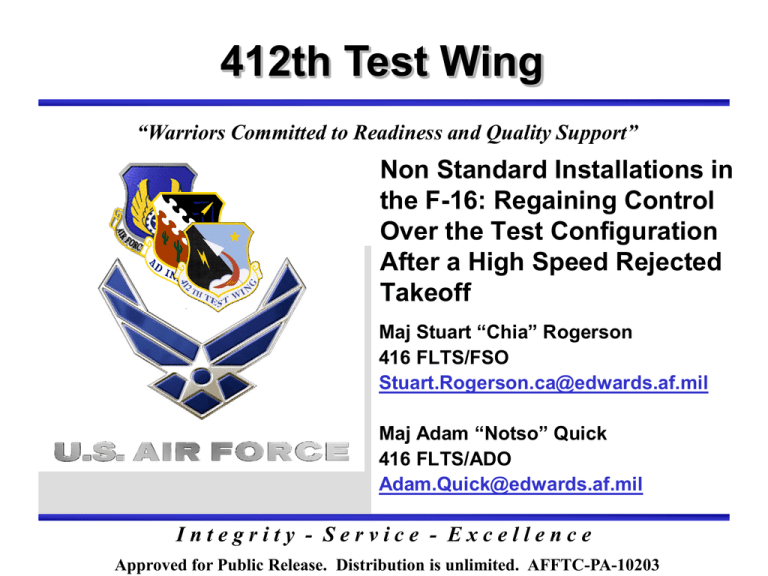
412th Test Wing “Warriors Committed to Readiness and Quality Support” Non Standard Installations in the F-16: Regaining Control Over the Test Configuration After a High Speed Rejected Takeoff Maj Stuart “Chia” Rogerson 416 FLTS/FSO Stuart.Rogerson.ca@edwards.af.mil Maj Adam “Notso” Quick 416 FLTS/ADO Adam.Quick@edwards.af.mil Integrity - Service - Excellence Approved for Public Release. Distribution is unlimited. AFFTC-PA-10203 Outline • • • • • • • Project background The close call Findings Risks during a High Speed aborted takeoff More configuration problems discovered CTF Corrective Actions Conclusions 2 Background • F-16D Block 25 highly modified to the 42 standard • Normally has a older model less powerful engine installed • Selected as test aircraft for a synthetic fuel program • Required installation of a newer model engine • Non standard motor for this aircraft • Scheduled mission was the first flight with the newer engine installed, baseline profile with JP8 • Aircraft was in a clean configuration • Test profile required an AB takeoff The Close Call… The Close Call… • Engine light illuminated and test aircrew commenced a high speed abort at 120 knots • Note it takes time for engine to spool down: max speed was 168 KCAS • Aircraft engaged the barrier successfully 5 The Close Call… • Test crew did an outstanding job bringing the aircraft to a safe stop • Hot brakes did not occur • But we were lucky… – – – – – Well executed emergency response Clean configured aircraft, so light weight Departure end cable was available Runway was dry Temperature was not high Findings • Engine data and MUX data did not provide an explanation for the engine light • Subsequent ground run at high power recreated the problem • Maintenance was able to determine that the wrong Engine Warning System (EWS) was installed for the newer model engine 7 EWS • Engine caution light is triggered by one of the following for the older model engine: – RPM becomes subidle – Engine stagnates (determined from RPM/FTIT rates) – Two seconds after FTIT exceeds 1000°C • Older model FTIT limit is 965°C at MIL/AB with a transient of 980°C • Newer model FTIT limit is 1070°C MIL/AB with a transient of 1090°C • Aircraft was aborted for a FALSE indication 8 EWS cont… • Two types of EWS – Old version which is only compatible with the older model engine – New version which is compatible with both the older and newer engine models 9 Configuration Control • The Prep Sheet – Key document in preparing the aircraft for test – Prepared by an experienced FTE who owns that aircraft – Sections include: OPS, CONFIG, INSTR, OFPs and REMARKS 10 Configuration Control… • REMARKS section is the backbone of the Prep Sheet • When modifying an aircraft, items in REMARKS may come from – – – – Safety Package Previous test programs Knowledge from the aircraft’s FTE Test team • Critical to have an experienced team to ensure the Prep sheet is an accurate relevant document 11 Findings cont… • So why did the EWS not get changed? – EWS part number was not verified because that action was not ordered on the prep sheet – A verification was not ordered on the prep sheet because the list of the aircraft’s Line Replaceable Units (LRU) incorrectly stated that the correct part number was installed – Why was the LRU part number listed incorrectly? • We don’t know for sure, but someone may have assumed the new EWS was installed because it was compatible with both engine models 12 Rejected Takeoff • Higher risk maneuver which often ends with catastrophic consequences Class A - Similar Incident • • • • • • • False avionics problem occurred at 120 KCAS Decided to abort Aircraft speed peaked at 168 KCAS Heavyweight configuration Missed the cable Barrier was not raised at the end of the runway Pilot ejected just prior to aircraft departing runway at 56 KCAS Class A cont… • External fuel tanks ruptured, ignited and fuel was thrown onto the aircraft and the surrounding area • Pilot descended into the fire and became disoriented, and was entangled in the molten parachute around his legs, falling to the ground • Pilot died from his injuries 55 days after the mishap Hot Brakes • Even if you are able to stop on the runway, hot brakes are likely with a high potential for a brake fire • Maybe no injuries or fatalities, but loss or severe damage to test asset is likely Configuration Problem #2 • Maintenance investigation into Engine warning light revealed a Hardware / Software incompatibility of the Engine Control (EC) / Diagnostic Unit (DU) combination (non standard configuration) • Test team had consulted with Depot and contractor representatives to verify that the EC and DU were suitable for the test – told it was good to go • However, data analysis showed that engine diagnostic codes were not being properly reported, including cockpit warnings 17 Configuration Problem #3 • Different aircraft involved in a High AOA test program • Maintenance paperwork review picked up an anomaly with the aircraft weight after a few missions • Subsequent investigation revealed a problem with the weight and balance information for the engine due to incorrect paperwork of the mod status • Shifted the CG slightly aft, which is in the direction of badness...(but we didn’t have to repeat the tests) 18 CTF Response • Three significant configuration problems discovered in the span of about 2 weeks • Commander’s Call for the entire CTF • Meeting of the Grey Beards with the following marching orders: – Identify any other potential configuration problems with CTF aircraft – Correct the current problems – Long term fixes to prevent future similar occurrences • However, fixes would need to be both internal and external to the CTF 19 Short Term Fixes • Changed EWS, updated paperwork on config and conducted high power engine run to test system – Low power run had been conducted for the engine install prior to first flight, but this obviously did not stress the system enough • New OFPs for the SMS and FCC to fix the data incompatibility between the EC and the DU • Verified mod status of engine via borescope, reweighed the test aircraft and fixed the paperwork • Physically verified critical LRUs in both squadron Frankenjet aircraft (and will post phase on the third) • Cross checked engine serial numbers at squadron with modification records and looked for discrepancies 20 Long Term Fixes • Changes were made to squadron policy and procedures – After any test modification, critical LRUs must be physically verified – Acceptance of aircraft from depot / off station / non Test Wing organization, physical verification of critical LRUs must be performed 21 Long Term Fixes … • Incorporate appropriate build up approach to stress the non standard configuration – Only conducted low power run (schedule pressures?). High power run would have found the problem – How do we “stress the system” to build confidence? – Via meeting of the Grey Beards early in the program to determine test configuration, how that configuration will be implemented and how we can build confidence that the configuration will work 22 Long Term Fixes … • Stress the System – No guarantee it will catch all problems, but that is the inherent risk of test – Some stress tests are obvious – engine testing – Other programs may have a unique solution to stress the system – But they can all follow the same process to try and determine that stress – Currently building that process into squadron policy 23 External challenges • First challenge: Incorrect mod status of engine was an external problem • How do you fix organizations outside your control that have a configuration control problem? – Can’t adopt the attitude of don’t trust outside agencies – Can’t just stick your nose in to some else's business – Need an SMS culture, where the focus is on improvement not blame 24 External challenges • Multi part solution – Be extra vigilant at the beginning until confidence is built that the problems have been corrected – Provide feedback to the non-flying organization so they appreciate the true impact of errors – they may not work up close and personal with the aircrew and aircraft – Make them part of the team to instill a sense of responsibility for the safety of the mission 25 External challenges • Second challenge: Contractor said items were compatible – they weren’t. Now what? – Again, inherent risk of test, you will sometimes miss certain outcomes – However smaller test programs have been moving away from onsite contractor involvement • Need to rebuild the team concept • Big difference between sending an email or talking over the phone when compared to being on site getting your hands dirty • Will increase that personal connection to the program which will naturally increase motivation to do a better job 26 External challenges • However, increasing contractor involvement will raise costs – Program managers need to try and budget this type of support – Can still be very challenging to decide when to bring in that on site support grey beard support – But remember identifying problems early in a program will always save time and money in the long run 27 Outline • • • • • • • • Project background The close call Findings Risks during a High Speed aborted takeoff Related Class A More configuration problems discovered CTF Corrective Actions Conclusions 28 QUESTIONS? 29

